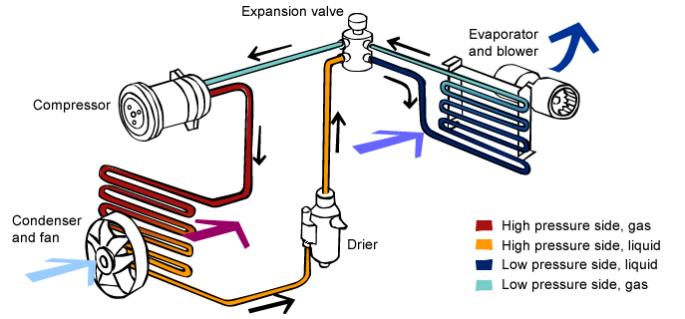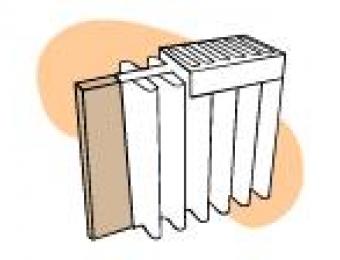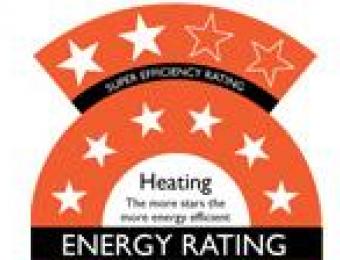Reverse cycle air conditioners, or heat pumps as they're commonly known, work by extracting heat from outside air and transferring it inside. They use a refrigerant to warm (or cool in summer months) the air that is being drawn inside. They can also filter and dehumidify the air. Heat pump heaters are also generally more efficient than other electric heaters.

Types of reverse cycle air conditioner
- Split systems
- Wall/window mounted
- Cassette units
- Multi-head split systems
- Ducted systems
Split system air conditioners
Split system air conditioners consist of two components – an outdoor unit and an indoor unit. For a reverse cycle split system air conditioner, the outdoor unit contains the compressor, while the indoor unit contains the condenser and evaporator components of the air conditioner. In a conventional (i.e. non-reverse cycle) air conditioner, the condenser component is normally also a part of the outdoor unit.
The outdoor and indoor units are connected together by piping that carries the refrigerant needed to heat (or cool) the outside air. If you only intend to use the air conditioner as a heater, you should install the outdoor unit closer to the floor to allow for more efficient operation during what's known as the 'heating cycle'. If, however, you want to use it for both heating and cooling, then you’ll need to install the outdoor unit higher up the wall. Domestic split system air conditioners vary in the amount of heat they can put out, but are typically suitable for rooms up to 100m2.
Multi-split systems use the same technology as standard split systems, but can have up to seven indoor units attached to a single outdoor unit, allowing better climate control for individual zones in your home, and better energy efficiency when several indoor units are run at the same time. Designed efficiently, these systems are also suitable for use in rooms up to 200m2.
Wall or window mounted air conditioners
Wall or window mounted units are by far the most affordable type of reverse cycle air conditioner. This is because they have all of their parts in one box, and are generally a lot easier to install – you just have to secure them to a window frame (or a hole in the wall) and plug them in. They are suitable for rooms up to 70m2.
Cassette air conditioners
Cassette units are also split-system units, but with the indoor unit mounted on the roof. These systems are generally stronger than wall mounted units, and are often designed for commercial or industrial use. As such, they vary greatly in terms of their abilities. As a rough guide, domestic systems can cool an area around 90m2, depending on insulation and window exposure.
Ducted air conditioners
Ducted systems are the most expensive type of reverse cycle system, as they require a separate ducting system to be installed, connecting all the rooms in your home to one central area. With a typical ducted system, each vent or duct is capable of heating a room with an area of around 80m2.
Installation requirements
Before opting for a reverse cycle system there are a few points you need to take into consideration, such as your local climate. Some reverse cycle systems won’t operate in temperatures of less than 5°C.
It is also necessary to determine how large your room is, and to buy a heater that has a kW capacity that is big enough to fulfil your needs. A system that is too small will run up a lot of excess power costs. Generally speaking, you will need an output of approximately 100W per metre squared of heat output to adequately heat a room.
Energy efficiency and labelling
Every air conditioner and electric heater made in or imported to Australia since 1987 is subject to Minimum Energy Performance Standards (MEPS). The only real exclusions that apply to residential installations are multi-split systems (i.e., those having more than one indoor unit with an independent control for each). The efficiency of different air conditioners can be compared using a star rating system, that gives a relative indication of how efficient a particular system is compared to other available systems.
All refrigerative air conditioners in Australia are sold with energy efficiency labels.In April 2010, new labelling requirements came into play and the MEPS process required the determination of how much power these devices consumed in standby mode. It also saw a change to the star ratings values. What used to be a 'five star' air conditioner could now only be a three star unit. There are now up to 10 star ratings, with six to ten star rated appliances highlighted with a second row of stars on the label. The labels reflect different efficiencies for both the heating efficiency and cooling efficiency of the system.
Where do I put it?
Depending on whether you are using the system just for heating, or if you intend for it to both heat and cool, the placement of the outdoor unit is vital. For heating only applications, place the outdoor unit close to the floor. For heating and cooling, place the condenser higher, at a height of about 1.5 to 2 metres.
The placement of the indoor unit mostly comes down to personal choice, but it's wise to avoid placing it directly above electrical fittings or equipment if possible, in case any water ever leaks from it. Likewise, positioning it to allow for direct flow of hot or cold air to wherever you sit or sleep is a fairly sensible idea.
|
Advantages
|
Disadvantages
|





